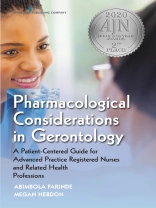Underscores the complexity of prescribing drugs for older adults while providing state-of-the-art guidelines for safe patient care
An evidence-based, quick-access reference for adult gerontology nurse practitioners and related healthcare providers, this text describes a holistic, patient-centered approach to prescribing drugs to older adults. Comprehensive yet concise writing distills timely guidance on the complexities of safely prescribing to this unique population.
This book opens with physiologic changes and assessment considerations for older adults, followed by a discussion of pharmacokinetics and pharmacodynamics, then a final section on guidelines for drug selection, drug interactions, and multimorbidities. Each chapter presents information in a consistent, easy-to-read template. Patient Care Pearls alert readers to crucial information and relevant case studies with examples of inappropriate medical prescribing provide context for drug delivery. Key points and chapter summaries help reinforce information. Additional features include the provision of guidelines for psychotropic medications in LTC facilities, special considerations for frail older adults, and the role of pharmacists as a resource for other practitioners.
- Key Features:
- Decision-making guidance on prescribing practices in varied settings
- Discusses in depth physiological considerations including multimorbidity and polypharmacy
- Presents Beer’s Criteria and its implications
- Guidelines for psychotropic medications in LTC facilities
- Special considerations for frail older adults
- Patient Care Pearls, case studies, key points, and chapter summaries
विषयसूची
The development of this book is dedicated to my loving family and friends who provided me with the motivation to begin and finish this process. It is with their unwavering support that I dedicate this publication to them all.
—Abimbola Farinde
I dedicate this work to my husband and children who help me remember the important things in life.
—Megan Hebdon
Contents
Contributors
Preface
Acknowledgments
SECTION I: INTRODUCTION TO THE GERIATRIC PATIENT
1. Physiologic Changes That Occur in Geriatric Patients
2. The Examination of the Geriatric Patient
SECTION II: INTRODUCTION TO PHARMACOKINETICS AND PHARMACODYNAMICS OF THE GERIATRIC PATIENT
3. Pharmacokinetics/Pharmacodynamics of the Geriatric Patient
4. Aging and Pharmacokinetic Impact
5. Available Guidelines for Therapeutic Drug Selections in Geriatric Patients
6. Drug–Drug Interactions
7. Drug–Food Interactions
8. Common Medications for Comorbidities and Side Effects
9. Available Drug Therapies Utilized in Geriatric Patients
SECTION III: GUIDELINES FOR DOSING GERIATRIC PATIENTS BY DISORDERS/BODY SYSTEMS
10. Guidelines for Dosing Geriatric Patients
11. Auditory Disorders
12. Neurologic Disorders
13. Hematologic Disorders
14. Nutritional Issues
15. Endocrine Disorders
16. Hyperlipidemia
17. Cardiovascular Disorders
18. Respiratory Disorders
19. Gastrointestinal Disorders
20. Central Nervous System Impairments
21. Mental Disorders
22. Musculoskeletal Disorders
23. Pain Management
24. Renal Impairments
25. Genitourinary Pharmacotherapy, Urinary Tract Infections, and Sexual Health
SECTION IV: PRESCRIBING CONSIDERATIONS UNIQUE TO THE GERIATRIC POPULATION
26. The Beers Criteria for Inappropriate Medication Use in Older Adults
27. Examples of Inappropriate Medication Prescribing
28. Polypharmacy and Nonadherence/Patient Education Tips
Index
लेखक के बारे में
Megan Hebdon, Ph D, DNP, RN, NP-C, is a professor and primary care provider who has worked in a variety of clinical settings with older adults including long-term care, home health, oncology, pain management, internal medicine, and primary care.












